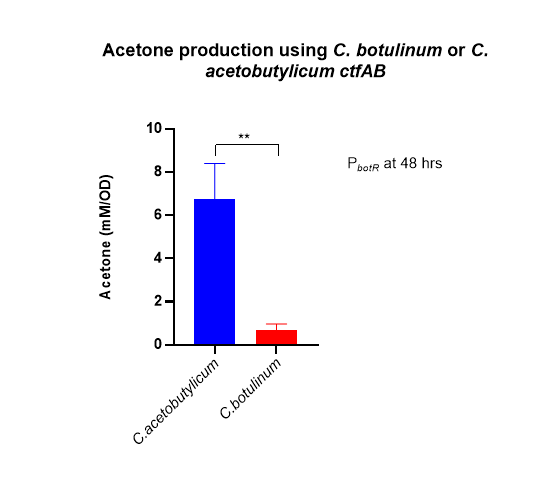Part:BBa_K2992032
RBS region for the ctfA gene from C. botulinum
RBS region for the ctfA gene from C. botulinum.
Usage and Biology
This parts entry represents the RBS for the ctfA gene in C. botulinum. The CtfAB complex is central to the production of biotechnologically relevant solvents in C. acetobutylicum such as acetone and butanol. The complex catalyses the conversion of acetoacetyl-CoA to acetoacetate concomitant with the transfer of CoA to acetate and butyrate. The CtfAB complex is a core component of our acetone production pathway to validate the use of volatile reporters to predict botulinum toxin production following food manufacturing processes. We have tested both C. acetobutylicum and C. botulinum-derived ctfAB.
Characterisation
This part is the ribosome binding site for the translation of the ctfA gene from C. botulinum . This was integrated in to the larger composite parts: BBa_K2992028, BBa_K2992029 and BBa_K2992030 . See results pagefor more
<br
Having established the functionality of our chosen promoters. We next assessed the feasibility of using these to drive acetone production in our reporter strains. In our design approach, we rationalized that either C. botulinum BBa_K2992003 BBa_K2992007 BBa_K2992005 or C. acetobutylicum-derived ctfAB [BBa_M36581. BBa_M36582, encoding the A and B subunits of the butyrate-acetoacetate CoA-transferase complex, should permit acetone production. To test this, we transformed pMTL82151 plasmids encoding our acetone pathways using C. botulinum ctfAB BBa_K2992029 or C. acetobutylicum ctfAB BBa_K2992036, both under the control of PntnH, into our PbotR-botR reporter strain of C. sporogenes.

The data clearly indicates that ctfAB from C. acetobutylicum was much better suited to providing acetone production capacity to our C. sporogenes reporter strains. These data have provided clear insight into the design strategy for any future exploits of our reporter strains for using acetone production as a model for safely predicting Botulinum neurotoxin production in foodstuffs. >
Sequence and Features
- 10COMPATIBLE WITH RFC[10]
- 12COMPATIBLE WITH RFC[12]
- 21COMPATIBLE WITH RFC[21]
- 23COMPATIBLE WITH RFC[23]
- 25COMPATIBLE WITH RFC[25]
- 1000COMPATIBLE WITH RFC[1000]
References
Cornillot, E., Croux, C. and Soucaille, P. (1997). Physical and genetic map of the Clostridium acetobutylicum ATCC 824 chromosome. Journal of Bacteriology, 179(23), pp.7426-7434.
| None |
